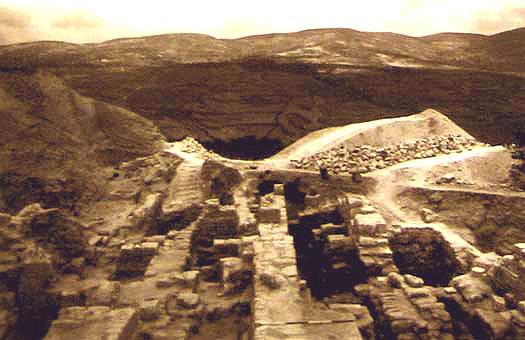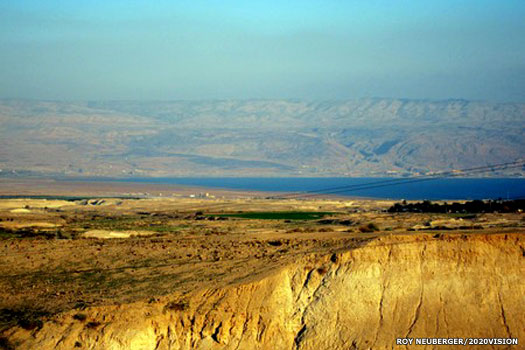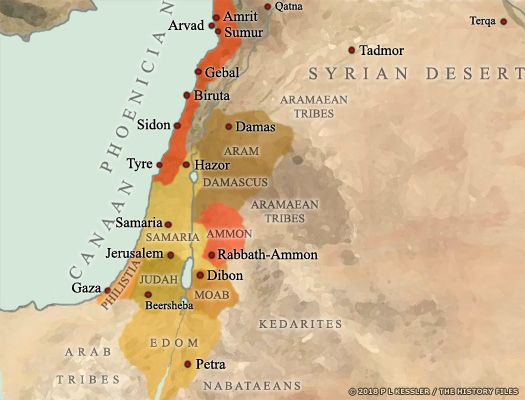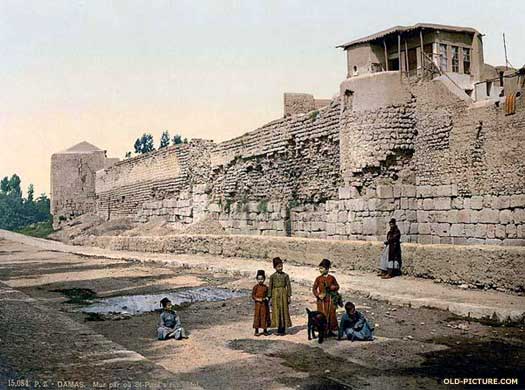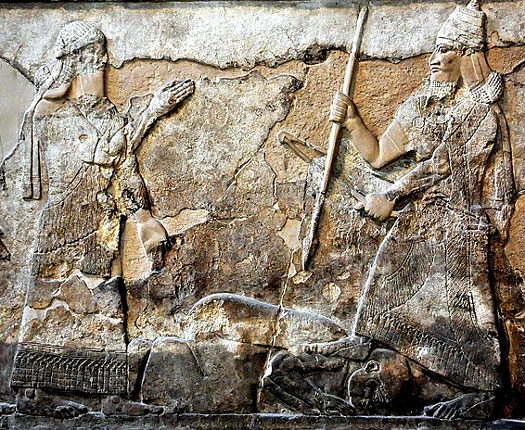
| KINGDOM OF ISRAEL / SAMARIA 928 - 723 BC :
Around 1035 BC the comparatively weak Israelites reputedly founded a small kingdom of Israel. The process seems to have been due - at least in part - to attacks by Ammon. The Israelites realised the only effective response was to unite the Israelite tribes. Once it had been regained from the Philistines, another major threat, the capital became the small walled city of Jerusalem. The kingdom held a largely united front until civil war divided it in two (according to the Old Testament).
The capital of the rebellious north was initially Sechem (Sichem - usually associated with the archaeological site of Tell Balata in the West Bank). By the time of the third king, Baasha, the capital was now at Tirza (Tirzah - now Tell el-Far'ah (North)), which the Israelites had conquered around the 1160s BC, during the settlement period. From about 875 BC the capital was at Samaria thanks to Omri, and this is sometimes used to name the kingdom as a whole. The city of Bashan formed part of its northern territory at first, as did Moab and Ammon to the east, but Israel's break-up allowed its enemy Damas to greatly increase its own power. The situation was not helped by Samaria and Judah continuing their civil war, on and off, under successive rulers.
To help break the northern population's ties with Jerusalem still further, Samaria's first king, Jeroboam I, created two sanctuaries, at Bethel in the south (very close to the border with Judah), and Dan in the north, both important cultic centres. He introduced forms of worship which could easily be accepted by the people but which were also easily attacked by Judah as being idolatrous. However, it was in Judah, or by Judeans, that much of the Old Testament was written, so Samaria was often painted in unflattering tones.
Additionally, even the Old Testament is unable to completely hide the fact that polytheism seemed to be prevalent throughout Canaan, even Hebrew Canaan. The early god El, who unmasked himself to Abraham as Yahweh, may have had a consort called Asherah, and a court of lesser gods in the typical format of Canaanite societies. Perhaps Jeroboam was simply being more true to the origins of his people while the Babylonian period Judeans who wrote down the books that make up the Old Testament had a completely different viewpoint.
All dating here is arguable to an extent. Various scholars have proposed their own dating which can result in variances of four or five years up or down from the dates that are shown here. The kingship was somewhat unstable in that it was often seized by usurpers and the previous ruling family would be murdered in its entirety. Ishida (see references) suggests that this was due to internal fueding within the kingdom, with tribe pitted against tribe for superiority.
(Information by Peter Kessler, with additional information by Wayne McCleese, from the BBC documentary series, Bible's Buried Secrets, first broadcast 22 March 2011, from Unger's Bible Dictionary, Merrill F Unger (1957), from Easton's Bible Dictionary, Matthew George Easton (1897), from The Changes of Dynasties in the Northern Kingdom, Tomoo Ishida (Walter de Gruyter Gmbh, 1977), and from External Links: Israel and the Aramaeans (Quartz Hill School of Theology), and Jewish Encyclopaedia, and Bible Hub: Menahem.)
928 - 907 BC :
Jeroboam I : Son of Nebat. Former Ephramite chief of Solomon's labour gangs.
928 - 925 BC :
The break-up of Israel has allowed Damas to rapidly grow in power and at times even threaten the existence of its southern neighbour. It is frequently called upon by Judah to help against Samaria and probably gains some of the latter's northern towns during this period. Also not specifically mentioned in the Old Testament, Wayne McCleese believes that a treaty exists between Tab-Rimmon of Damas and the kingdom of Judah (based on 1 Kings 15:19).
This general view of the 1933 excavations of the city of Samaria shows them while looking towards the north c.925 BC :
Egyptian Pharaoh Sheshonk mounts a full-scale invasion of the kingdom, mainly ignoring Judah to the south. Many treasures are captured but the Ark of the Covenant, contrary to some opinion, is not taken to Egypt.
Some modern scholars outside the orthodox Egyptologists and Biblical scholars prefer the idea that the Shishak who attacks Israel is probably not Sheshonk but Ramses II of Nineteenth Dynasty Egypt instead, placing the event a clear two centuries before the generally accepted date of Israel's foundation as a kingdom and even further before the building of the First Temple into which the Ark is placed.
906 - 905 BC :
Nadab : Son. Killed by Philistines (or by Baasha).
905 BC :
Nadab's reign is brief. He leads the siege of a Philistine town by the name of Gibbethon when he is killed. The Old Testament's first book of Kings states that this is by one of his own captains - one Baasha - rather than by a Philistine. Baasha goes on to wipe out the remainder of the royal family, thereby extinguishing the House of Jereboam.
Baasha : Former army captain. Usurper?
905 - 883 BC :
While attacking Asa of Judah, Samaria certainly does now lose some of its northern towns to Damas, although this event goes unrecorded by the Old Testament. Samaria's king probably has to make important concessions to the Damascene king, Ben-Hadad. Control over Ammon is also lost around 880 BC.
883 - 881 BC :
Elah : Son. Murdered by the captain of chariots.
881 BC :
Zimri : Usurper. Ruled for seven days. Suicide.
881 - 870 BC :
Omri : Army commander. Oppressor of the Moabites.
c.880 - 848 BC :
Moab is oppressed by Omri and his son, Ahab. These two Israelite kings head a new dynasty in Samaria, and this is the first direct mention of Israelite rulers outside of the Old Testament. Omri also establishes closer ties with the Phoenicians at Tyre in an attempt to draw away some of Damas' wealth and prosperity. The Assyrians make themselves known, referring to Samaria as Bit-Humri ('House of Omri'), and his successors as Mar-Humri ('Son of Omri'). Omri's footprint in history makes him far more credible as a powerful early Israelite than his predecessor, Kind David, but he is barely mentioned by the Old Testament, which is written down by people from Judah.
The Plains of Moab lay on the eastern side of the River Jordan, opposite Jericho, and it was here that the Israelites mourned the death of Moses for one month prior to entering the 'Promised Land' (presumably the Moabites lacked the resources to hurry them along) 870 - 848 BC :
Ahab : Son. m Jezebal, dau of king of Tyre. Killed by Damas.
860s? BC :
Asa of Judah and Ba'asa (Baasha), ruler of Ammon, maintain a near-lifelong feud. When Ba'asa pushes Samaria's frontier to within five miles of Jerusalem, Asa, just like his father before him when under pressure, calls on Damas for help. In this case it is Ben-Hadad who responds to Asa's offer of payment if Damas will break its treaty with Ammon.
855 - 854 BC :
Ahab further strengthens Samaria's position by concluding a treaty with Tyre which is cemented by marriage. To that he adds a protective alliance with Judah, sealed with the marriage of his daughter, Athalia, to Jehoram, the crown prince of Judah.
In 855 BC, the long-awaited attack by Damas arrives. After burning Hazor, King Ben-Hadad and thirty-two vassal kings suddenly appear before the gates of Samaria, but they are strategically defeated twice in two years (although this attack may be a misattribution by later editors of the Old Testament and may instead refer to the throwing off of Damascene domination by Jehoash in the early eighth century BC).
853 BC :
Ahab is a member of an alliance of states which also includes Ammon, Arvad, Byblos, Damas, Edom, Egypt, Hamath, and Kedar (seemingly despite the recent conflict between Damas and Samaria). Together they fight Shalmaneser III of Assyria at the Battle of Qarqar which consists of the largest known number of combatants in a single battle to date, and is the first historical mention of the Arabs from the southern deserts. Despite claims to the contrary, the Assyrians are defeated, since they do not press on to their nearest target, Hamath, and do not resume their attacks on Hamath and Damas for about six years.
When the Neo-Assyrian empire threatened the various city states of southern Syria and Canaan around 853 BC, they united to protect their joint territory - successfully it seems, at least for a time 850 - 848 BC :
The alliance of states of 853 BC breaks up when Ahab, assisted by Jehoshaphat of Judah, wages war against Damas at Ramoth Gilead, where Ahab meets his death in 848 BC. Damas subsequently removes Bashan from Samarian control. Ahab's third successor (in 842 BC) is Jehu. Almost immediately after his accession, Hazael usurps the throne of Aram Damascus, murdering the incumbent king in the process.
848 - 847 BC :
Ahaziah : Son. Weak and sickly. Moab rebels during his reign.
847 - 842 BC :
Joram / Jehoram : Son of Ahab. Killed by Jehu.
c.847 BC :
Joram, together with Jehoshaphat of Judah, and the king (or governor) of Edom, form a coalition which attempts to retake Moab by force but, despite some initial gains, the attempt is unsuccessful. Despite Old Testament claims to the contrary, Moab even invades and defeats Samaria.
842 BC :
Ahaziah of Judah and Joram of Samaria engage Hazael of Damas in battle at Ramoth-Gilead (seemingly a common location for battles in this period). Joram is wounded and retreats to Jezreel where Ahaziah rejoins him. Both are killed there by Jehu, who then seizes the throne of Samaria.
842 - 814 BC :
Jehu : Army commander. Usurper?
c.840 BC :
Jehu puts an end to the house of Omri by massacring the entire royal family and seizing the throne. The only known survivor is Omri's daughter, Athaliah, who is queen in Judah. Soon after his reign begins, and despite Old Testament claims to the contrary, Moab defeats Samaria and Damas takes all the Hebrew possessions east of the Jordan, ravaging Judah, and rendering Samaria impotent. Later in his reign, Jehu is also represented on the Black Obelisk of Shalmaneser III as submitting to Assyria, the only representation of an Israelite ruler in existence today.
814 - 800 BC :
Jehoahaz : Son. Remained cowed by Damas.
800 - 784 BC :
Jehoash / Joash : Son.
c.796 BC : Ben-Hadad III of Damas is not the man his father had been. Initially he occupies the greater part of Samaria but introduces repressive controls which are so strongly resented that the Samarians even welcome the return of the Assyrians.
This colour photochrome print shows a wall in Damascus' defences which is rumoured to be the one over which St Paul escaped in the first century AD Return they do around this time, attacking Damas and forcing tribute from it. This attack is almost certainly led by Shamshi-ilu from his western base at Kar-Shulmanu-Ashared. He is perhaps the most powerful man of his time, one of a small group of almost equally powerful magnates - princes who govern Assyria under the sovereignty of Adad-Nirari and his three immediate successors.
Gradually losing his father's empire, Ben-Hadad also leads a coalition of states against Zakir of Hamath, and Luash to the north of Damas, but is defeated by the latter. Samaria under Jehoash is even able to recover to the extent that it is able to throw off his domination, and later makes Damas a vassal state.
784 - 748 BC :
Jeroboam II : Son.
748 BC :
Zachariah / Zechariah : Son. Ruled for 6 months. Murdered.
748 BC :
Shallum : Army captain. Usurper. Ruled for 1 month. Killed.
748 - 738 BC :
Menachem / Menahem : Son of Gadi. Army captain. Usurper.
748 BC :
Wayne McCleese has pointed out that the name Menahem is missing (defaced) from the Assyrian inscription that describes Tiglath-Pileser III overwhelming him 'like in a snowstorm'. McCleese assumes that the name has therefore been assumed, although from where is unclear. The name means 'one who comforts' - ironic for a king who is claimed as being a tyrannical and cruel idolater. His name may, however, exist on more recently-discovered Assyrian tablets, as well as being recorded in the Old Testament's 2 Kings.
738 BC :
The Assyrians are now extremely active in the Levant. The city of Byblos pays tribute in this year, and the Assyrian king, Tiglath-Pileser III, campaigns in Sam'al against a rebellion there. Both Samaria and Damas become vassals following an invasion of their lands. However, the kings of the two cities are allowed to continue to rule.
738 - 733 BC :
Pekahiah : Son. Murdered.
733 - 732 BC :
Pekah : Son of Remaliah. Army officer. Usurper. Murdered.
734 - 733 BC :
Pekah and Rezon II of Damas form an anti-Assyrian coalition. They try to force Ahaz of Judah to join them but are stopped when Tiglath-Pileser III marches an army into Syria and the Levant (partially thanks to payments of silver and gold by Ahaz). Over the next two years he re-conquers all the rebellious states, and takes Damas. Judah is reduced to vassal status in 733 BC. Just a year later Pekah is assassinated by Hoshea who then takes over the kingship.
Tiglath-Pileser III dominated the Levantine city states during the later years of the eighth century BC, terminating the kingdom of Samaria and, shown here, with his foot on the shoulder of Hanunu of the Philistine city of Gaza, a gesture of dominance in the face of Hanunu's crouched submission 732 - 723 BC :
Hoshea : Ostensibly pro-Assyrian to assuage Tiglath-Pileser III.
722 - 721 BC :
After Hoshea stops paying tribute, Samaria is invaded and eventually falls to Assyria. The ten (of twelve) Hebrew tribes in Israel are relocated by the Assyrians (27,290 inhabitants in all). A proportion of them are resettled in Media in the Zagros Mountains, forced to walk all the way. It is often assumed that the rest may be massacred by the Assyrians, although it now seems more likely that they are eventually absorbed into general Assyrian society.
In their place, the residents of the rebellious city of Hamath are shipped in, and it is these people who form the core of the later Samaritans (whose name may be due to their relationship with the lands of Samaria - although this is a contested claim). The former kingdom is divided into provinces: Megiddo (north-west), Samaria (west of the River Jordan), and Gilead (east of the River Jordan).
Source :
https://www.historyfiles.co.uk/ |
